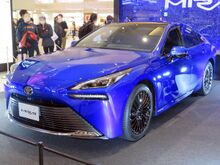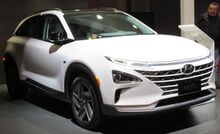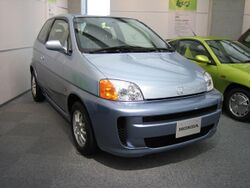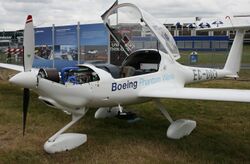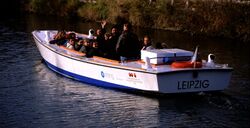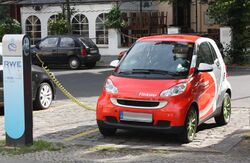Engineering:Fuel cell vehicle
A fuel cell vehicle (FCV) or fuel cell electric vehicle (FCEV) is an electric vehicle that uses a fuel cell, sometimes in combination with a small battery or supercapacitor, to power its onboard electric motor. Fuel cells in vehicles generate electricity generally using oxygen from the air and compressed hydrogen. Most fuel cell vehicles are classified as zero-emissions vehicles that emit only water and heat. As compared with internal combustion vehicles, hydrogen vehicles centralize pollutants at the site of the hydrogen production, where hydrogen is typically derived from reformed natural gas.[1] Transporting and storing hydrogen may also create pollutants.[2] Fuel cells have been used in various kinds of vehicles including forklifts, especially in indoor applications where their clean emissions are important to air quality, and in space applications. Fuel cells are being developed and tested in trucks, buses, boats, ships, motorcycles and bicycles, among other kinds of vehicles.
The first road vehicle powered by a fuel cell was the Chevrolet Electrovan, introduced by General Motors in 1966.[3] The Toyota FCHV and Honda FCX, which began leasing on December 2, 2002, became the world's first government-certified commercial fuel cell vehicles,[4][5][6] and the Honda FCX Clarity, which began leasing in 2008, was the world's first fuel cell vehicle designed for mass production rather than adapting an existing model.[7] In 2013, Hyundai Motors began production of the Hyundai ix35 FCEV, claimed to be the world's first mass-produced fuel cell electric vehicle,[8][9][10] which was subsequently introduced to the market as a lease-only vehicle.[11][12] In 2014, Toyota began selling the Toyota Mirai, the world's first dedicated fuel cell vehicle.[13][14][15]
(As of December 2020), 31,225 passenger FCEVs powered with hydrogen had been sold worldwide.[16] (As of 2021), there were only two models of fuel cell cars publicly available in select markets: the Toyota Mirai (2014–present) and the Hyundai Nexo (2018–present). The Honda Clarity was produced from 2016 to 2021, when it was discontinued.[17] As of 2020, there was limited hydrogen infrastructure, with fewer than fifty hydrogen fueling stations for automobiles publicly available in the U.S.[18] Critics doubt whether hydrogen will be efficient or cost-effective for automobiles, as compared with other zero-emission technologies, and in 2019, The Motley Fool opined: "What's tough to dispute is that the hydrogen fuel cell dream is all but dead for the passenger vehicle market."[19]
Description and purpose of fuel cells in vehicles
All fuel cells are made up of three parts: an electrolyte, an anode and a cathode.[20] In principle, a hydrogen fuel cell functions like a battery, producing electricity, which can run an electric motor. Instead of requiring recharging, however, the fuel cell can be refilled with hydrogen.[21] Different types of fuel cells include polymer electrolyte membrane (PEM) Fuel Cells, direct methanol fuel cells, phosphoric acid fuel cells, molten carbonate fuel cells, solid oxide fuel cells, reformed methanol fuel cell and Regenerative Fuel Cells.[22]
History
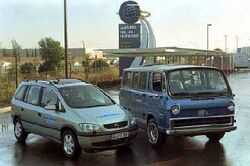
The concept of the fuel cell was first demonstrated by Humphry Davy in 1801, but the invention of the first working fuel cell is credited to William Grove, a chemist, lawyer, and physicist. Grove's experiments with what he called a "gas voltaic battery" proved in 1842 that an electric current could be produced by an electrochemical reaction between hydrogen and oxygen over a platinum catalyst.[24] English engineer Francis Thomas Bacon expanded on Grove's work, creating and demonstrating various alkaline fuel cells from 1939 to 1959.[25]
The first modern fuel cell vehicle was a modified Allis-Chalmers farm tractor, fitted with a 15 kilowatt fuel cell, around 1959.[26] The Cold War Space Race drove further development of fuel cell technology. Project Gemini tested fuel cells to provide electrical power during crewed space missions.[27][28] Fuel cell development continued with the Apollo Program. The electrical power systems in the Apollo capsules and lunar modules used alkali fuel cells.[27] In 1966, General Motors developed the first fuel cell road vehicle, the Chevrolet Electrovan.[29] It had a PEM fuel cell, a range of 120 miles and a top speed of 70 mph. There were only two seats, as the fuel cell stack and large tanks of hydrogen and oxygen took up the rear portion of the van. Only one was built, as the project was deemed cost-prohibitive.[30]
General Electric and others continued working on PEM fuel cells in the 1970s.[27] Fuel cell stacks were still limited principally to space applications in the 1980s, including the Space Shuttle.[27] However, the closure of the Apollo Program sent many industry experts to private companies. By the 1990s, automobile manufacturers were interested in fuel cell applications, and demonstration vehicles were readied. In 2001, the first 700 Bar (10000 PSI) hydrogen tanks were demonstrated, reducing the size of the fuel tanks that could be used in vehicles and extending the range.[31]
Applications
There are fuel cell vehicles for all modes of transport. The most prevalent fuel cell vehicles are cars, buses, forklifts and material handling vehicles.[32]
Automobiles
Honda established the world's first fuel cell vehicle dealer network in 2008, and at the time was the only company able to lease hydrogen fuel cell vehicles to private customers.[33][34] The Honda FCX Clarity was introduced in 2008 for leasing by customers in Japan and Southern California and discontinued by 2015. From 2008 to 2014, Honda leased a total of 45 FCX units in the US.[35] Over 20 other FCEV prototypes and demonstration cars were released in that time period,[36] including the GM HydroGen4,[29] and Mercedes-Benz F-Cell.
The Hyundai ix35 FCEV Fuel Cell vehicle was available for lease from 2014 to 2018,[37] when 54 units were leased.[38] In 2018, Hyundai introduced the Nexo.[39]
Sales of the Toyota Mirai to customers began in Japan in December 2014. Most of the initial customers were expected to be governments and corporations, not individuals.[40] Pricing started at ¥6,700,000 (~US$57,400) before taxes and a government incentive of ¥2,000,000 (~US$19,600).[41] Former European Parliament President Pat Cox estimated that Toyota initially would lose about $100,000 on each Mirai sold.[42] (As of December 2017), global sales totaled 5,300 Mirais. The top selling markets were the U.S. with 2,900 units, Japan with 2,100 and Europe with 200.[43]
In 2015, Toyota announced that it would offer all 5,680 patents related to hydrogen fuel cell vehicles and hydrogen fuel cell charging station technology, which it has been researching for over 20 years, to its competitors free of charge in order to stimulate the market for hydrogen-powered vehicles.[44]
The Honda Clarity Fuel Cell was produced from 2016 to 2021.[45][46] The 2017 Clarity had the highest combined and city fuel economy ratings among all hydrogen fuel cell cars rated by the EPA that year, with a combined city/highway rating of 67 miles per gallon gasoline equivalent (MPGe), and 68 MPGe in city driving.[47] In 2019, Katsushi Inoue, the president of Honda Europe, stated, "Our focus is on hybrid and electric vehicles now. Maybe hydrogen fuel cell cars will come, but that's a technology for the next era."[48]
By 2017, Daimler phased out its FCEV development, citing declining battery costs and increasing range of EVs,[49] and most of the automobile companies developing hydrogen cars had switched their focus to battery electric vehicles.[50] By 2020, only three car makers were still manufacturing, or had active manufacturing programs for hydrogen cars.[51]
Fuel economy
The following table compares EPA's fuel economy expressed in miles per gallon gasoline equivalent (MPGe) for the two models of hydrogen fuel cell vehicles rated by the EPA (As of September 2021), and available in California.[47]
| Comparison of fuel economy expressed in MPGe for hydrogen fuel cell vehicles available for sale or lease in California and rated by the U.S. Environmental Protection Agency (As of September 2021)[47] | |||||||
|---|---|---|---|---|---|---|---|
| Vehicle | Model year | Combined fuel economy |
City fuel economy |
Highway fuel economy |
Range | Annual fuel cost | |
| Hyundai Nexo | 2019–2021 | 61 mpg-e | 65 mpg-e | 58 mpg-e | 380 mi (610 km) | ||
| Toyota Mirai | 2016–2020 | 66 mpg-e | 66 mpg-e | 66 mpg-e | 312 mi (502 km) | ||
| Toyota Mirai | 2021 | 74 mpg-e | 76 mpg-e | 71 mpg-e | 402 mi (647 km) | ||
| Notes: One kg of hydrogen has roughly the same energy content as one U.S. gallon of gasoline.[52] | |||||||
Fuel cells powered by an ethanol reformer
In June 2016, Nissan announced plans to develop fuel cell vehicles powered by ethanol rather than hydrogen. Nissan claims this technical approach would be cheaper, and that it would be easier to deploy the fueling infrastructure than a hydrogen infrastructure.[53] The vehicle would include a tank holding a blend of water and ethanol, which is fed into an onboard reformer that splits it into hydrogen and carbon dioxide. The hydrogen is then fed into a solid oxide fuel cell. According to Nissan, the liquid fuel could be an ethanol-water blend at a 55:45 ratio.[53]
Buses

(As of 2020), 5,648 hydrogen fuel cell buses were in use around the world, with 93.7% of them in China .[54]
From the late 1980s, concern regarding diesel emissions from buses led to experimentation with fuel cells to power them. After initial experiments with phosphoric acid fuel cells, hydrogen-powered fuel-cell buses were tested in cities in the late 1990s.[55] In the 2000s, buses entered trial service in cities around the world; the European Union supported the research project Clean Urban Transport for Europe.[56]
By the 2010s, commercial introduction of hydrogen fuel cell buses was underway around the world.[57][58] However, many transit operators were purchasing battery electric buses instead, as these were cheaper to operate and purchase.[59] However, battery electric buses lacked range compared to diesel buses, take time to charge (often overnight, compared with hydrogen fuel cell buses, which can be refilled quickly) and have reduced energy storage in cold weather. Some companies have proposed using the fuel cell as a range extender, combining it with a larger battery or a supercapacitor.[60]
Hydrogen fuel cell buses have historically been significantly more expensive to purchase and operate than diesel, hybrid or electric buses.[55][59] In recent years, costs have been reduced to levels comparable with diesel buses.[61]
A variety of bus manufacturers are currently producing hydrogen fuel cell buses.[62][63][64] Bus manufacturers usually work with a provider of hydrogen fuel cells to power the bus, such as Ballard Power Systems or Toyota.[62][63]
Forklifts
A fuel cell forklift (also called a fuel cell lift truck or a fuel cell forklift) is a fuel cell-powered industrial forklift truck used to lift and transport materials. Most fuel cells used in forklifts are powered by PEM fuel cells.[65]
In 2013, there were over 4,000 fuel cell forklifts used in material handling in the US[66] of which 500 received funding from DOE (2012).[67][68] As of 2024, approximately 50,000 hydrogen forklifts are in operation worldwide (the bulk of which are in the U.S.), as compared with 1.2 million battery electric forklifts that were purchased in 2021.[69]
PEM fuel-cell-powered forklifts provide significant benefits over petroleum powered forklifts as they produce no local emissions. Fuel-cell forklifts can work for a full 8-hour shift on a single tank of hydrogen, can be refueled in 3 minutes and have a lifetime of 8–10 years. Fuel cell-powered forklifts are often used in refrigerated warehouses as their performance is not degraded by lower temperatures.[70] In design the FC units are often made as drop-in replacements.[71][72]
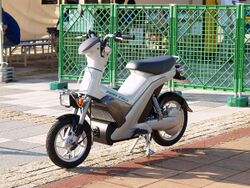
Motorcycles and bicycles
In 2005, the British firm Intelligent Energy produced the first working hydrogen run motorcycle called the ENV (Emission Neutral Vehicle). It holds enough fuel to run for four hours, and to travel 160 km (100 mi) in an urban area, at a top speed of 80 km/h (50 mph).[73] There are other examples of bikes[74] and bicycles[75] with a hydrogen fuel cell engine. The Suzuki Burgman received "whole vehicle type" approval in the EU.[76] The PHB was a hydrogen bicycle with an electric motor. It debuted in Shanghai in 2008,[77] but it was discontinued due to lack of hydrogen fuel services. Its predecessor was a hydrogen bicycle called Palcan, based in Vancouver , Canada.[78]
Airplanes
Boeing researchers and industry partners throughout Europe conducted experimental flight tests in February 2008 of a crewed airplane powered only by a fuel cell and lightweight batteries. The Fuel Cell Demonstrator Airplane, as it was called, used a Proton-Exchange Membrane (PEM) fuel cell/lithium-ion battery hybrid system to power an electric motor, which was coupled to a conventional propeller.[79] In 2003, the world's first propeller driven airplane to be powered entirely by a fuel cell was flown. The fuel cell was a unique FlatStack stack design which allowed the fuel cell to be integrated with the aerodynamic surfaces of the plane.[80]
There have been several fuel cell powered unmanned aerial vehicles (UAV). A Horizon fuel cell UAV set the record distance flown by a small UAV in 2007.[81] The military is especially interested in this application because of the low noise, low thermal signature and ability to attain high altitude. In 2009, the Naval Research Laboratory's (NRL's) Ion Tiger utilized a hydrogen-powered fuel cell and flew for 23 hours and 17 minutes.[82] Boeing is completing tests on the Phantom Eye, a high-altitude, long endurance (HALE) to be used to conduct research and surveillance flying at 20,000 m (65,000 ft) for up to four days at a time.[83] Fuel cells are also being used to provide auxiliary power for aircraft, replacing fossil fuel generators that were previously used to start the engines and power on board electrical needs.[83] Fuel cells can help airplanes reduce CO2 and other pollutant emissions and noise.
Boats
The world's first Fuel Cell Boat HYDRA used an AFC system with 6.5 kW net output. For each liter of fuel consumed, the average outboard motor produces 140 times less[citation needed] the hydrocarbons produced by the average modern car. Fuel cell engines have higher energy efficiencies than combustion engines, and therefore offer better range and significantly reduced emissions.[84] Amsterdam introduced its first fuel cell powered boat in 2011 that ferries people around the city's canals.[85]
Submarines
The first submersible application of fuel cells is the German Type 212 submarine.[86] Each Type 212 contains nine PEM fuel cells, spread throughout the ship, providing between 30 kW and 50 kW each of electrical power.[87] This allows the Type 212 to remain submerged longer and makes them more difficult to detect. Fuel cell powered submarines are also easier to design, manufacture, and maintain than nuclear-powered submarines.[88]
Trains
In March 2015, China South Rail Corporation (CSR) demonstrated the world's first hydrogen fuel cell-powered tramcar at an assembly facility in Qingdao.[89] 83 miles of tracks for the new vehicle were built in seven Chinese cities. China had plans to spend 200 billion yuan ($32 billion) over the next five years to increase tram tracks to more than 1,200 miles.[90]
In 2016, Alstom debuted the Coradia iLint, a regional train powered by hydrogen fuel cells. It was designed to reach 140 kilometres per hour (87 mph) and travel 600–800 kilometres (370–500 mi) on a full tank of hydrogen.[91] The train entered service in Germany in 2018 and is expected to be tested in the Netherlands beginning in 2019.[92]
Swiss manufacturer Stadler Rail signed a contract in California to supply a hydrogen fuel cell train in the US, the FLIRT H2 train, in 2024 as part of the Arrow commuter rail service.[93]
Trucks
For transport applications such as long-haul trucks, fuel cells are a potential solution for zero emission transport. A 2022 study in Energies magazine cites relatively fast refueling times compared with electric truck charging times and the current limitations of the energy density of batteries, but they note that "operating constraints" include the "high amount of CO2 emissions [caused by] hydrogen production", the lack of storage and refueling infrastructure, H2 leakage and safety challenges, efficiency "losses in compression, storage and dispensing", .[94]
In 2020, Hyundai started to manufacture hydrogen powered 34-ton cargo trucks under the model name XCIENT, making an initial shipment of 10 of the vehicles to Switzerland. They are able to travel 400 kilometres (250 mi) on a full tank and take 8 to 20 minutes to fill up.[95]
In 2022, Total Transportation Services (TTSI), Toyota Logistics Services (TLS), UPS, and Southern Counties Express (SCE) are operating a 12-month "Shore-to-Store (S2S) project" running hydrogen fuel cell trucks on trips from Los Angeles area ports.[96][97] The Kenworth T680 hydrogen prototype used in Los Angeles and Long Beach was unveiled in 2018 and has also been tested in the Seattle area.[98]
Hydrogen infrastructure
Eberle and Rittmar von Helmolt stated in 2010 that challenges remain before fuel cell cars can become competitive with other technologies and cite the lack of an extensive hydrogen infrastructure in the U.S.:[99] (As of July 2020), there were 43 publicly accessible hydrogen refueling stations in the US, 41 of which were located in California.[18] In 2013, Governor Jerry Brown signed AB 8, a bill to fund $20 million a year for 10 years to build up to 100 stations.[100] In 2014, the California Energy Commission funded $46.6 million to build 28 stations.[101]
Japan got its first commercial hydrogen fueling station in 2014.[102] By March 2016, Japan had 80 hydrogen fueling stations, and the Japanese government aims to double this number to 160 by 2020.[103] In May 2017, there were 91 hydrogen fueling stations in Japan.[104] Germany had 18 public hydrogen fueling stations in July 2015. The German government hoped to increase this number to 50 by end of 2016,[105] but only 30 were open in June 2017.[106]
Codes and standards
Under United Nations global technical regulations for wheeled vehicles, specifically regarding hydrogen usage, there are international standards which define aspects of engineering and overall integrity, performance, safety, part lifecycle, and various other categories. One notable area of these regulations is regarding the compressed hydrogen storage systems that typically reach the end of qualified service life at 15 or fewer years in use.[107]
US programs
In 2003, US President George Bush proposed the Hydrogen Fuel Initiative (HFI). The HFI aimed to further develop hydrogen fuel cells and infrastructure technologies to accelerate the commercial introduction of fuel cell vehicles. By 2008, the U.S. had contributed 1 billion dollars to this project.[108] In 2009, Steven Chu, then the US Secretary of Energy, asserted that hydrogen vehicles "will not be practical over the next 10 to 20 years".[109][110] In 2012, however, Chu stated that he saw fuel cell cars as more economically feasible as natural gas prices had fallen and hydrogen reforming technologies had improved.[111][112] In June 2013, the California Energy Commission granted $18.7M for hydrogen fueling stations.[113] In 2013, Governor Brown signed AB 8, a bill to fund $20 million a year for 10 years for up to 100 stations.[100] In 2013, the US DOE announced up to $4 million planned for "continued development of advanced hydrogen storage systems".[114] On May 13, 2013, the Energy Department launched H2USA, which is focused on advancing hydrogen infrastructure in the US.[115]
Cost
By 2010, advancements in fuel cell technology had reduced the size, weight and cost of fuel cell electric vehicles.[116] In 2010, the U.S. Department of Energy (DOE) estimated that the cost of automobile fuel cells had fallen 80% since 2002 and that such fuel cells could potentially be manufactured for $51/kW, assuming high-volume manufacturing cost savings.[117] Fuel cell electric vehicles have been produced with "a driving range of more than 250 miles between refueling".[117] They can be refueled in less than 5 minutes.[118] Deployed fuel cell buses have a 40% higher fuel economy than diesel buses.[116] EERE's Fuel Cell Technologies Program claims that, as of 2011, fuel cells achieved a 42 to 53% fuel cell electric vehicle efficiency at full power,[116] and a durability of over 75,000 miles with less than 10% voltage degradation, double that achieved in 2006.[117] In 2012, Lux Research, Inc. issued a report that concluded that "Capital cost ... will limit adoption to a mere 5.9 GW" by 2030, providing "a nearly insurmountable barrier to adoption, except in niche applications". Lux's analysis concluded that by 2030, PEM stationary fuel cell applications will reach $1 billion, while the vehicle market, including fuel cell forklifts, will reach a total of $2 billion.[119]
As of September 2023, hydrogen cost $36 per kilogram at public charging stations in California, 14 times as much per mile for a Mirai as compared with a Tesla Model 3.[120] The average price in Germany in 2023 is 12.5 euro per kg.[121]
Environmental impact
The environmental impact of fuel cell vehicles depends on the primary energy with which the hydrogen was produced. Fuel cell vehicles are only environmentally benign when the hydrogen was produced with renewable energy.[122] If this is the case fuel cell cars may be cleaner and more efficient than fossil fuel cars. However, they are not as efficient as battery electric vehicles which consume much less energy.[123] Usually a fuel cell car consumes 2.4 times more energy than a battery electric car, because electrolysis and storage of hydrogen is much less efficient than using electricity to directly load a battery.[122] In addition, a 2023 study by the Centre for International Climate and Environmental Research (CICERO) estimated that leaked hydrogen has a global warming effect 11.6 times stronger than CO₂.[124]
As of 2009, motor vehicles used most of the petroleum consumed in the U.S. and produced over 60% of the carbon monoxide emissions and about 20% of greenhouse gas emissions in the United States, however production of hydrogen for hydrocracking used in gasoline production, chief amongst its industrial uses, was responsible for approximately 10% of fleet wide greenhouse gas emissions.[125] A vehicle fueled with pure hydrogen emits few pollutants at the tailpipe, producing mainly water and heat, although the production of the hydrogen would create pollutants unless the hydrogen used in the fuel cell were produced using only renewable energy.[126]
In 2006, Ulf Bossel stated that the large amount of energy required to isolate hydrogen from natural compounds (water, natural gas, biomass), package the light gas by compression or liquefaction, transfer the energy carrier to the user, plus the energy lost when it is converted to useful electricity with fuel cells, leaves around 25% for practical use."[127] Richard Gilbert, co-author of Transport Revolutions: Moving People and Freight without Oil (2010), comments similarly, that producing hydrogen gas ends up using some of the energy it creates. Then, energy is taken up by converting the hydrogen back into electricity within fuel cells. "'This means that only a quarter of the initially available energy reaches the electric motor' ... Such losses in conversion don't stack up well against, for instance, recharging an electric vehicle (EV) like the Nissan Leaf or Chevy Volt from a wall socket".[128][129] A 2010 well-to-wheels analysis of hydrogen fuel cell vehicles report from Argonne National Laboratory states that renewable H2 pathways offer much larger green house gas benefits.[130] This result has recently been confirmed.[122] In 2010, a US DOE well-to-wheels publication assumed that the efficiency of the single step of compressing hydrogen to 6,250 psi (43.1 MPa) at the refueling station is 94%.[131] A 2016 study in the November issue of the journal Energy by scientists at Stanford University and the Technical University of Munich concluded that, even assuming local hydrogen production, "investing in all-electric battery vehicles is a more economical choice for reducing carbon dioxide emissions, primarily due to their lower cost and significantly higher energy efficiency."[132]
Criticism of fuel cell cars
In 2008, professor Jeremy P. Meyers, in the Electrochemical Society journal Interface wrote that fuel cells "are not as efficient as batteries, due primarily to the inefficiency of the oxygen reduction reaction. ... [T]hey make the most sense for operation disconnected from the grid, or when fuel can be provided continuously. For applications that require frequent and relatively rapid start-ups ... where zero emissions are a requirement, as in enclosed spaces such as warehouses."[133] Also in 2008, Wired News reported that "experts say it will be 40 years or more before hydrogen has any meaningful impact on gasoline consumption or global warming, and we can't afford to wait that long. In the meantime, fuel cells are diverting resources from more immediate solutions."[134] In 2008, Robert Zubrin, the author of Energy Victory, said: "Hydrogen is 'just about the worst possible vehicle fuel'".[135] If hydrogen could be produced using renewable energy, "it would surely be easier simply to use this energy to charge the batteries of all-electric or plug-in hybrid vehicles."[135] The Los Angeles Times wrote in 2009, "Any way you look at it, hydrogen is a lousy way to move cars."[136] The Washington Post asked in November 2009, "[W]hy would you want to store energy in the form of hydrogen and then use that hydrogen to produce electricity for a motor, when electrical energy is already waiting to be sucked out of sockets all over America and stored in auto batteries...?"[137]
The Motley Fool stated in 2013 that "there are still cost-prohibitive obstacles [for hydrogen cars] relating to transportation, storage, and, most importantly, production."[138] Volkswagen's Rudolf Krebs said in 2013 that "no matter how excellent you make the cars themselves, the laws of physics hinder their overall efficiency. The most efficient way to convert energy to mobility is electricity." He elaborated: "Hydrogen mobility only makes sense if you use green energy", but ... you need to convert it first into hydrogen "with low efficiencies" where "you lose about 40 percent of the initial energy". You then must compress the hydrogen and store it under high pressure in tanks, which uses more energy. "And then you have to convert the hydrogen back to electricity in a fuel cell with another efficiency loss". Krebs continued: "in the end, from your original 100 percent of electric energy, you end up with 30 to 40 percent."[139]
In 2014, electric automotive and energy futurist Julian Cox wrote that producing hydrogen from methane "is significantly more carbon intensive per unit of energy than coal. Mistaking fossil hydrogen from the hydraulic fracturing of shales for an environmentally sustainable energy pathway threatens to encourage energy policies that will dilute and potentially derail global efforts to head-off climate change due to the risk of diverting investment and focus from vehicle technologies that are economically compatible with renewable energy."[140] In 2014, former Dept. of Energy official Joseph Romm concluded that renewable energy cannot economically be used to make hydrogen for an FCV fleet "either now or in the future."[141] GreenTech Media's analyst reached similar conclusions in 2014.[142] In 2015, Clean Technica listed some of the disadvantages of hydrogen fuel cell vehicles.[143][144]
A 2017 analysis published in Green Car Reports found that the best hydrogen fuel cell vehicles consume "more than three times more electricity per mile than an electric vehicle ... generate more greenhouse-gas emissions than other powertrain technologies ... [and have] very high fuel costs. ... Considering all the obstacles and requirements for new infrastructure (estimated to cost as much as $400 billion), fuel-cell vehicles seem likely to be a niche technology at best, with little impact on U.S. oil consumption.[104] In 2017, Michael Barnard, writing in Forbes , listed the continuing disadvantages of hydrogen fuel cell cars and concluded that "by about 2008, it was very clear that hydrogen was and would be inferior to battery technology as a storage of energy for vehicles. [B]y 2025 the last hold outs should likely be retiring their fuel cell dreams.”[145] A 2019 video by Real Engineering noted that using hydrogen as a fuel for cars does not help to reduce carbon emissions from transportation. The 95% of hydrogen still produced from fossil fuels releases carbon dioxide, and producing hydrogen from water is an energy-consuming process. Storing hydrogen requires more energy either to cool it down to the liquid state or to put it into tanks under high pressure, and delivering the hydrogen to fueling stations requires more energy and may release more carbon. The hydrogen needed to move a FCV a kilometer costs approximately eight times as much as the electricity needed to move a BEV the same distance.[146] Also in 2019, Katsushi Inoue, the president of Honda Europe, stated, "Our focus is on hybrid and electric vehicles now. Maybe hydrogen fuel cell cars will come, but that's a technology for the next era."[48]
Assessments since 2020 have concluded that hydrogen vehicles are still only 38% efficient, while battery EVs from 80% to 95% efficient.[147][148] A 2021 assessment by CleanTechnica concluded that while hydrogen cars are far less efficient than electric cars, the vast majority of hydrogen being produced is polluting grey hydrogen, and delivering hydrogen would require building a vast and expensive new infrastructure, the remaining two "advantages of fuel cell vehicles – longer range and fast fueling times – are rapidly being eroded by improving battery and charging technology."[51] A 2022 study in Nature Electronics agreed.[149]
Innovation
Fuel cell patent fillings in the area of hydrogen fuel cells increased in the 1960s, partly due to NASAs space program; another increase in the 80s was driven by research for automobiles. This was followed by a surge in filings from 2000 to 2005 by inventors in Japan, US and South Korea. Since then, China has dominated patent fillings in the field, with a smaller number in Japan, Germany, South Korea and the US.[150] Between 2016 and 2020, annual filings, particularly for transportation applications, increased by a further 23%.[151][152]
Almost 80% of the patents in the area of fuel cells for transportation were filed by car companies.[153] Academia is collaborating actively with the industry.[154] Although filings related to road vehicles such as cars and trucks dominate, inventions in other areas like shipping, aviation, rail and other special vehicles is increasing.[155] Airbus, a major aircraft manufacturer, has increased its patenting activity in the area since 2019.[156] The number of fuel cell patents for shipping applications is comparable in size to the one for aviation and similarly slow in growth.[154]
A 2022 World Intellectual Property Organization report argues that because heavy-duty vehicles, such as construction vehicles, forklifts, and airport tugs require a higher payload, the high energy density of hydrogen can make fuel cells a more advantageous solution than battery applications.[156]
See also
- Hydrogen vehicle
- Glossary of fuel cell terms
- Proton-exchange membrane fuel cell
- Reformed methanol fuel cell
- Fuel cell auxiliary power unit
- Fuel Cell and Hydrogen Energy Association
- Hydrogen fuel enhancement
- Water-fuelled car
Notes
- ↑ "Hydrogen Production: Natural Gas Reforming". https://www.energy.gov/eere/fuelcells/hydrogen-production-natural-gas-reforming.
- ↑ "How Do Hydrogen Fuel Cell Vehicles Work?". Union of Concerned Scientists. Retrieved July 24, 2016.
- ↑ "The history of hydrogen fuel cell cars". The Market Herald. December 29, 2021. https://www.carsguide.com.au/car-advice/the-history-of-hydrogen-fuel-cell-cars-85330.
- ↑ 4.0 4.1 "Toyota to lease fuel-cell cars to state". The Japan Times. 19 November 2002. https://www.japantimes.co.jp/news/2002/11/19/business/toyota-to-lease-fuel-cell-cars-to-state/.
- ↑ 5.0 5.1 "First Honda FCX Fuel Cell Vehicles Delivered on Same Day in Japan and the U.S.". Honda. 3 December 2002. https://global.honda/newsroom/news/2002/4021203-fcx-eng.html.
- ↑ "Hydrogen-powered Honda achieves world first". The Japan Times. 26 July 2002. https://www.japantimes.co.jp/news/2002/07/26/business/hydrogen-powered-honda-achieves-world-first/#.XDN1-XZ_q3A.
- ↑ "Honda FCX Clarity, world's first series production fuel cell car". Verizon Media. November 18, 2007. https://www.autoblog.com/2007/11/18/first-drive-2009-honda-fcx-clarity-worlds-first-series-produc/.
- ↑ "Hyundai Motor's fuel-cell car sales miss target". Yonhap News Agency. 15 June 2015. http://english.yonhapnews.co.kr/full/2015/06/15/38/1200000000AEN20150615002600320F.html.
- ↑ "Hyundai ix35 Fuel Cell", accessed November 18, 2018
- ↑ "The World’s First Mass-Production of FCEV", accessed November 18, 2018
- ↑ "Hyundai ix35 Fuel Cell launching in 2014 with free hydrogen fuel". Drive.com.au. 22 November 2013. https://www.drive.com.au/news/hyundai-ix35-fuel-cell-launching-in-2014-with-free-hydrogen-fuel/.
- ↑ "The Tucson Fuel Cell FAQ | HyundaiHydrogen.ca". http://www.hyundaihydrogen.ca/faq.html.
- ↑ "Toyota's Fuel-Cell Car Mirai Goes on Sale". The Wall Street Journal. 15 December 2014. https://blogs.wsj.com/japanrealtime/2014/12/15/toyotas-fuel-cell-powered-mirai-hits-showrooms/?guid=BL-JRTB-18738&dsk=y.
- ↑ "Toyota to quadruple production of Mirai fuel-cell vehicles by 2017". The Japan Times. 23 January 2015. https://www.japantimes.co.jp/news/2015/01/23/business/corporate-business/toyota-to-quadruple-production-of-mirai-fuel-cell-vehicles-by-2017/#.VZqmPXZ_q3B.
- ↑ "Toyota Mirai x Hydrogen: the world's first mass produced HFCV". January 20, 2017. https://www.adrianflux.co.uk/influx/features/toyota-mirai-hydrogen/.
- ↑ International Energy Agency (IEA), Clean Energy Ministerial, and Electric Vehicles Initiative (EVI) (2021-04-29). "Global EV Outlook 2021: Accelerating ambitions despite the pandemic". International Energy Agency. https://www.iea.org/reports/global-ev-outlook-2021. Go to the Global EV Data Explorer tool and choose "EV Stock", "Cars" and "World" for global stock, and "Country" for the country stock.
- ↑ "Honda discontinues hydrogen-fuelled Clarity FCV due to slow sales". June 16, 2021. https://www.autocar.co.uk/car-news/industry-news-manufacturing/honda-discontinues-hydrogen-fuelled-clarity-fcv-due-slow-sales.
- ↑ 18.0 18.1 Alternative Fueling Station Counts by State, Alternative Fuels Data Center, accessed July 2, 2020
- ↑ Hoium, Travis (July 25, 2022). "Hydrogen Cars Appear Dead as EVs Take the Reins". https://www.fool.com/investing/2019/04/23/hydrogen-cars-appear-dead-as-evs-take-the-reins.aspx.
- ↑ "Basics", U.S. Department of Energy, Retrieved on: 2008-11-03.
- ↑ "What Is a Fuel Cell?" , The Online Fuel Cell Information Resource, Retrieved on: 2008-11-03.
- ↑ "Types of Fuel Cells" , U.S. Department of Energy, Retrieved on: 2008-11-03.
- ↑ John W. Fairbanks (August 30, 2004). "Engine Maturity, Efficiency, and Potential Improvements". Diesel Engine Emission Reduction Conference Coronado, California. US Department of Energy. p. 10. http://www1.eere.energy.gov/vehiclesandfuels/pdfs/deer_2004/session1/2004_deer_fairbanks.pdf.
- ↑ "Fuel Cell History - Fuel Cell Today". http://www.fuelcelltoday.com/history.
- ↑ "History of Hydrogen Cars and Technology, from 1802 to present!". https://www.greencarfuture.com/hydrogen/2018/10/30/history-of-hydrogen-cars.html#historical-times-1802-to-1999.
- ↑ Wand, George. “Fuel Cell History, Part 2” . “Fuel Cell Today”, April 2006, accessed August 2, 2011
- ↑ 27.0 27.1 27.2 27.3 “PEM Fuel Cells”. “Smithsonian Institution”, 2004, accessed August 2, 2011
- ↑ Dumoulin, Jim. “Gemini-V Information”. NASA - Kennedy Space Center, August 25, 2000, accessed August 2, 2011
- ↑ 29.0 29.1 Eberle, Ulrich; Mueller, Bernd; von Helmolt, Rittmar (2012-07-15). "Fuel cell electric vehicles and hydrogen infrastructure: status 2012". Royal Society of Chemistry. https://www.researchgate.net/publication/233987484.
- ↑ “1966 GM Electrovan”. “Hydrogen Fuel Cars Now”, accessed August 2, 2011
- ↑ “Hydrogen Storage Technology for the Hydrogen Economy” [yes|permanent dead link|dead link}}]. “Iljin Composite”, KCR, Korea, accessed August 2, 2011
- ↑ "Hydrogen Fueling Stations Could Reach 5,200 by 2020" . Environmental Leader: Environmental & Energy Management News, July 20, 2011, accessed August 2, 2011
- ↑ "Hydrogen-powered vehicles on horizon". 24 August 2009. https://www.washingtontimes.com/news/2009/aug/24/hydrogen-powered-vehicles-on-horizon/.
- ↑ "Honda Sets Up World's First Fuel Cell Dealer Network". The Car Connection. 16 June 2018. https://www.thecarconnection.com/news/1015667_honda-sets-up-worlds-first-fuel-cell-dealer-network.
- ↑ John Voelcker (2014-07-29). "Honda Ends Three Green Models For 2015: Insight, Fit EV, FCX Clarity". Green Car Reports. http://www.greencarreports.com/news/1092683_honda-ends-three-green-models-for-2015-insight-fit-ev-fcx-clarity.
- ↑ "Hydrogen and Fuel Cell Vehicles Worldwide". TÜV SÜD Industrie Service GmbH, accessed on August 2, 2011
- ↑ Voelcker, John. "The New Hyundai ix35", Hyundai, accessed December 7, 2014
- ↑ "Plug-In Electric Car Sales Continue Rise In 2014: 100,000-Plus Last Year", Green Car Reports, January 5, 2015
- ↑ Panait, Mircea. "2019 Hyundai Nexo Fuel Cell Vehicle Features 370 Miles of Range", AutoEvolution, January 9, 2018
- ↑ Yoko Kubota (2014-12-15). "Toyota's Fuel-Cell Car Mirai Goes on Sale". Japan Real Time (Wall Street Journal). https://blogs.wsj.com/japanrealtime/2014/12/15/toyotas-fuel-cell-powered-mirai-hits-showrooms/.
- ↑ Ken Moritsugu (2014-11-18). "Toyota to start sales of fuel cell car next month". Associated Press. Fox News Chicago. http://www.myfoxchicago.com/story/27410215/toyota-to-launch-fuel-cell-car-next-month.
- ↑ Ayre, James. "Toyota To Lose $100,000 On Every Hydrogen FCV Sold?", CleanTechnica.com, November 19, 2014; and Blanco, Sebastian. "Bibendum 2014: Former EU President says Toyota could lose 100,000 euros per hydrogen FCV sedan", GreenAutoblog.com, November 12, 2014
- ↑ "Toyota sells 1.52 million electrified vehicles in 2017, three years ahead of 2020 target" (Press release). Toyota City, Japan: Toyota. 2018-02-02. Retrieved 2018-02-03.
- ↑ "Toyota Wants Everyone to Know How It Made Its Hydrogen-Powered Car". Time (magazine). 5 January 2015. https://time.com/3654899/toyota-mirai-patents-hydrogen-power/.
- ↑ "Honda discontinues fuel cell car Clarity on weak demand". June 16, 2021. https://asia.nikkei.com/Business/Automobiles/Honda-discontinues-fuel-cell-car-Clarity-on-weak-demand.
- ↑ Millikin, Mike (2016-12-20). "Southern California customers take delivery of n>ew 2017 Honda Clarity Fuel Cell sedan". Green Car Congress. http://www.greencarcongress.com/2016/12/20161220-clarity.html.
- ↑ 47.0 47.1 47.2 United States Environmental Protection Agency and U.S. Department of Energy (September 2021). "Compare Fuel Cell Vehicles". http://www.fueleconomy.gov/feg/fcv_sbs.shtml. One kg of hydrogen is roughly equivalent to one U.S. gallon of gasoline.
- ↑ 48.0 48.1 Allen, James. "Honda: Now Is The Right Time to Embrace Electric Cars", The Sunday Times, November 4, 2019
- ↑ Quartier, Dieter (2017-04-04). "Hydrogen: BMW yes, Daimler not anymore". http://www.fleeteurope.com/en/news/hydrogen-bmw-yes-daimler-not-anymore.
- ↑ Williams, Keith. "The Switch from Hydrogen to Electric Vehicles Continues, Now Hyundai Makes the Move", Seeking Alpha, September 1, 2017
- ↑ 51.0 51.1 Morris, Charles. "Why Are 3 Automakers Still Hyping Hydrogen Fuel Cell Vehicles?", CleanTechnica, October 14, 2021
- ↑ "Appendix E – The Starting Point: A Discussion Paper Describing a Proposed Method of Sale and Quality Specification for Hydrogen Vehicle Fuel". U.S. National Work Group Meeting for the Development of Commercial Hydrogen Measurement Standards. National Institute of Standards and Technology. June 19, 2008. http://ts.nist.gov/WeightsAndMeasures/upload/H2-Laws-and-Reg-Paper-USNWG-JUN2008.pdf.
- ↑ 53.0 53.1 Voelcker, John (2016-06-14). "Nissan takes a different approach to fuel cells: ethanol". Green Car Reports. http://www.greencarreports.com/news/1104467_nissan-takes-a-different-approach-to-fuel-cells-ethanol.
- ↑ Can Samsun, Remzi; Antoni, Laurent; Rex, Michael; Stolten, Detlef (2021). "Deployment Status of Fuel Cells in Road Transport: 2021 Update". International Energy Agency (IEA) Advanced Fuel Cells Technology Collaboration Programme (AFC TCP) (Forschungszentrum Jülich). https://www.ieafuelcell.com/fileadmin/webfiles/2021-Deployment_status_of_fc_in_road_transport.pdf.
- ↑ 55.0 55.1 Eudy, L; Chandler, K; Gikakis, C (September 2007). "Fuel Cell Buses in U.S. Transit Fleets: Summary of Experiences and Current Status". pp. 1–2. https://www.nrel.gov/docs/fy07osti/41967.pdf.
- ↑ "European Fuel Cell Bus Project Extended by One Year". DaimlerChrysler. http://www.daimlerchrysler.com/dccom/0-5-7153-1-596003-1-0-0-0-0-0-8-7145-0-0-0-0-0-0-1.html.
- ↑ "Hydrogen bus launched on London tourist route". 2010-12-10. http://www.theguardian.com/environment/2010/dec/10/hydrogen-bus-london.
- ↑ "Toyota Launches Production Model "Sora" FC Bus". March 28, 2018. https://global.toyota/en/newsroom/corporate/21863761.html.
- ↑ 59.0 59.1 Hanley, Steve (2022-01-11). "French City Cancels Hydrogen Bus Contract, Opts For Electric Buses". https://cleantechnica.com/2022/01/11/french-city-cancels-hydrogen-bus-contract-opts-for-electric-buses/.
- ↑ "Hamburg to test the eCitaro with fuel cell range extender in 2021". 2019-09-05. https://www.sustainable-bus.com/fuel-cell-bus/hamburg-to-test-the-ecitaro-with-fuel-cell-range-extender-in-2021/.
- ↑ "Wuppertaler Stadtwerke: Cost parity between hydrogen and diesel buses". 2021-07-05. https://www.urban-transport-magazine.com/en/wuppertaler-stadtwerke-cost-parity-between-hydrogen-and-diesel-buses/.
- ↑ 62.0 62.1 "New Flyer launches new fuel cell bus model Xcelsior Charge FC (with Ballard technology and Siemens ELFA 3 drivetrain)". 2022-09-08. https://www.sustainable-bus.com/news/new-flyer-xcelsior-charge-fc-hydrogen-bus/.
- ↑ 63.0 63.1 "Toyota Launches Production Model "Sora" FC Bus". https://global.toyota/en/newsroom/corporate/21863761.html.
- ↑ "Hydrogen Fuel Cell Electric Bus". http://zhongtongbuses.com/10-3-hydrogen-fuel-cell-electric-bus.html.
- ↑ Konrad, Tom. "12 Hydrogen And Fuel Cell Stocks". https://www.forbes.com/sites/tomkonrad/2013/12/11/twelve-hydrogen-and-fuel-cell-stocks/.
- ↑ Fuel Cell Forklifts Gain Ground
- ↑ Fuel cell technologies program overview
- ↑ Economic Impact of Fuel Cell Deployment in Forklifts and for Backup Power under the American Recovery and Reinvestment Act
- ↑ Barnard, Michael. "On Hydrogen Forklifts, Bitcoin Mining and Green Fertilizer", CleanTechnica, January 2, 2024
- ↑ Full Fuel-Cycle Comparison of Forklift Propulsion Systems
- ↑ "Fuel cell technology". http://www.still.co.uk/fuel-cell-technology-uk.0.0.html.
- ↑ "Fuel cell forklift". http://graftechaet.com/getattachment/065811d2-720e-40c6-b236-0440c4d90d76/OFCC-Forklift-Case-Study.aspx.
- ↑ "The ENV Bike". Intelligent Energy. http://www.envbike.com/.
- ↑ 15. Dezember 2007. "Hydrogen Fuel Cell electric bike". Youtube.com. https://www.youtube.com/watch?v=B_Whbb_hlPs.
- ↑ "Horizon fuel cell vehicles: Transportation: Light Mobility" . Horizon Fuel Cell Technologies. 2010. Accessed August 2, 2011.
- ↑ "SUZUKI - BURGMAN Fuel-Cell Scooter". https://www.globalsuzuki.com/Burgman_Fuel-Cell_Scooter/index.html.
- ↑ "Fuel Cell Works Supplemental News Page". 2008-01-15. http://www.fuelcellsworks.com/Supppage7783.html.
- ↑ Röhrich, Klaus. "A Brief History of the Hydrogen Bicycle". https://panglosslabs.org/petite-histoire-du-velo-h2/.
- ↑ "Boeing Successfully Flies Fuel Cell-Powered Airplane". http://www.boeing.com/news/releases/2008/q2/080403a_nr.html.. Boeing. April 3, 2008. Accessed August 2, 2011.
- ↑ "First Fuel Cell Microaircraft". Archived from the original on January 6, 2010. https://web.archive.org/web/20100106235805/http://www.popularmechanics.com/technology/industry/1287561.html.
- ↑ "Horizon Fuel Cell Powers New World Record in UAV Flight" . Horizon Fuel Cell Technologies. November 1, 2007.
- ↑ "Fuel Cell Powered UAV Completes 23-hour Flight". Alternative Energy: News. October 22, 2009. Accessed August 2, 2011.
- ↑ 83.0 83.1 "Hydrogen-powered unmanned aircraft completes set of tests" .www.theengineer.co.uk. June 20, 2011. Accessed August 2, 2011.
- ↑ "Fuel Cells 2000 : Fuel Cell Basics : Applications". Archived from the original on May 15, 2011. https://web.archive.org/web/20110515080800/http://www.fuelcells.org/basics/apps.html.
- ↑ "Lovers introduces zero-emission boat" (in Dutch). NemoH2. March 28, 2011. Accessed August 2, 2011.
- ↑ "Super-stealth sub powered by fuel cell". Frederik Pleitgen. CNN Tech: Nuclear Weapons. February 22, 2011. Accessed August 2, 2011.
- ↑ "U212 / U214 Attack Submarines, Germany". naval-Technology.com. Accessed August 2, 2011.
- ↑ Hammerschmidt, Albert E. “Fuel Cell Propulsion of Submarines”. “Sea Siemens” Accessed August 3, 2011.
- ↑ "China Presents the World's First Hydrogen-Fueled Tram". http://en.yibada.com/articles/21142/20150321/china-worlds-first-hydrogen-fueled-tram.htm#.
- ↑ "China's Hydrogen-Powered Future Starts in Trams, Not Cars". March 25, 2015. https://www.bloomberg.com/news/articles/2015-03-25/china-s-hydrogen-powered-future-starts-in-trams-not-cars.
- ↑ "Alstom unveils its zero-emission train Coradia iLint at InnoTrans" (Press release). Alstom. 2016-09-20. Retrieved 2016-09-21.
- ↑ "Alstom to test its hydrogen fuel cell train in the Netherlands; first pilot project outside Germany", Green Car Congress, November 3, 2019
- ↑ Burgess, Molly (November 14, 2019). "First hydrogen train for the US". https://www.h2-view.com/story/contract-signed-for-first-ever-hydrogen-powered-train-in-the-us.
- ↑ Pardi, Shantanu, et. al. "A Review of Fuel Cell Powertrains for Long-Haul Heavy-Duty Vehicles: Technology, Hydrogen, Energy and Thermal Management Solutions", Energies, MDPI, December 16, 2022
- ↑ Jung, Ryu (July 7, 2020). "Hyundai Starts Mass Production of Hydrogen Trucks". Chosun Ilbo. http://english.chosun.com/site/data/html_dir/2020/07/07/2020070701792.html.
- ↑ "Getting more green trucks on the road". 2022-04-26. https://www.wcia.com/news/getting-more-green-trucks-on-the-road/.
- ↑ "Port of Los Angeles Rolls Out Hydrogen Fuel Cell Electric Freight Demonstration". June 8, 2021. https://lacity.gov/highlights/port-los-angeles-rolls-out-hydrogen-fuel-cell-electric-freight-demonstration.
- ↑ "Kenworth T680 Fuel Cell Heavy Truck". https://www.hydrogencarsnow.com/index.php/kenworth-t680-fuel-cell-heavy-truck/.
- ↑ Eberle, Ulrich and Rittmar von Helmolt. "Sustainable transportation based on electric vehicle concepts: a brief overview". Energy & Environmental Science, Royal Society of Chemistry, May 14, 2010, accessed August 2, 2011 (Subscription content?)
- ↑ 100.0 100.1 Xiong, Ben. "Governor Brown Signs AB 8" , California Fuel Cell Partnership, September 30, 2013
- ↑ "California investing nearly $50 million in hydrogen refueling stations" , California Energy Commission, May 1, 2014
- ↑ "Japan gets its first commercial hydrogen station for vehicles". July 14, 2014. https://www.japantimes.co.jp/news/2014/07/14/business/japan-gets-its-first-commercial-hydrogen-station-for-vehicles/.
- ↑ "Japan eyes 40,000 fuel-cell cars, 160 hydrogen stations by 2020". March 16, 2016. https://www.japantimes.co.jp/news/2016/03/16/business/japan-eyes-40000-fuel-cell-cars-160-hydrogen-stations-by-2020/.
- ↑ 104.0 104.1 Voelcker, John. "Energy use for hydrogen fuel-cell vehicles: higher than electrics, even hybrids (analysis)", Green Car Reports, May 4, 2017
- ↑ "CleanEnergyPartnership.de: FAQ - How Many Hydrogen Filling Stations Are There?". https://cleanenergypartnership.de/en/faq/hydrogen-infrastructure/.
- ↑ "H2-Stations", H2 Mobility Deutschland GmbH, June 2017
- ↑ "Global technical regulation on hydrogen and fuel cell vehicles". July 19, 2013. p. 12. https://unece.org/fileadmin/DAM/trans/main/wp29/wp29wgs/wp29gen/wp29registry/ECE-TRANS-180a13e.pdf.
- ↑ Nice, Karim, and Jonathan Strickland. "How Fuel Cells Work". How Stuff Works, accessed August 3, 2011
- ↑ Matthew L. Wald (2009-05-07), "U.S. Drops Research Into Fuel Cells for Cars", The New York Times, https://www.nytimes.com/2009/05/08/science/earth/08energy.html, retrieved 2009-05-09
- ↑ Bullis, Kevin. "Q & A: Steven Chu", Technology Review, May 14, 2009
- ↑ "Chu Changes Mind on Hydrogen", Autoline Daily at 2.10 of video
- ↑ Motavalli, Jim. "Cheap Natural Gas Prompts Energy Department to Soften Its Line on Fuel Cells", The New York Times, May 29, 2012
- ↑ Anderson, Mark. State grants $18.7M for hydrogen fueling stations, Sacramento Business Journal, June 13, 2013
- ↑ Energy Department Announces up to $4 Million for Advanced Hydrogen Storage, DOE, October 29, 2013
- ↑ "Energy Department Launches Public-Private Partnership to Deploy Hydrogen Infrastructure". http://energy.gov/articles/energy-department-launches-public-private-partnership-deploy-hydrogen-infrastructure.
- ↑ 116.0 116.1 116.2 Garbak, John. "VIII.0 Technology Validation Sub-Program Overview". DOE Fuel Cell Technologies Program, FY 2010 Annual Progress Report, accessed August 2, 2011
- ↑ 117.0 117.1 117.2 "Accomplishments and Progress" . Fuel Cell Technology Program, U.S. Dept. of Energy, June 24, 2011
- ↑ Wipke, Keith, Sam Sprik, Jennifer Kurtz and Todd Ramsden. "National FCEV Learning Demonstration" . National Renewable Energy Laboratory, April 2011, accessed August 2, 2011
- ↑ Brian Warshay, Brian. "The Great Compression: the Future of the Hydrogen Economy", Lux Research, Inc. January 2012
- ↑ Agatie, Cristian. "Hydrogen Cars Are Dead as Projects Are Scrapped and Refueling Prices Go Through the Roof", Auto Evolution, September 20, 2023
- ↑ "Handelsblatt". https://www.handelsblatt.com/unternehmen/energie/handelsblatt-wasserstoff-gipfel-fuer-lkw-koennte-gruener-wasserstoff-schon-bald-der-guenstigste-brennstoff-sein/29131578.html.
- ↑ 122.0 122.1 122.2 Notter, Dominic A.; Kouravelou, Katerina; Karachalios, Theodoros; Daletou, Maria K.; Haberland, Nara Tudela (2015-01-01). "Life cycle assessment of PEM FC applications: electric mobility and μ-CHP". Energy Environ. Sci. 8 (7): 1969–1985. doi:10.1039/c5ee01082a. http://xlink.rsc.org/?DOI=C5EE01082A.
- ↑ MZ Jacobson and Co., 100% clean and renewable wind, water, and sunlight (WWS) all-sector energy roadmaps for the 50 United States. In: Energy and Environmental Science 8, 2015, 2093-2117, doi:10.1039/C5EE01283J.
- ↑ Bjørnæs, Christian. "Global warming potential of hydrogen estimated", Centre for International Climate and Environmental Research, June 7, 2023. Retrieved June 15, 2023
- ↑ "Fuel Cells for Transportation", U.S. Department of Energy, updated September 18, 2009. Retrieved June 7, 2010
- ↑ "Fuel Cell Vehicles", Fuel Economy, Retrieved on: 2008-11-03.
- ↑ Zyga, Lisa. "Why a hydrogen economy doesn't make sense". physorg.com, December 11, 2006, accessed August 2, 2011, citing Bossel, Ulf. "Does a Hydrogen Economy Make Sense?" Proceedings of the IEEE. Vol. 94, No. 10, October 2006
- ↑ Gilbert, Richard and Anthony Perl (2010). Transport Revolutions: Moving People and Freight without Oil, New Society Publishers ISBN:0865716609
- ↑ "EarthTalk: High costs, hurdles keep hydrogen cell cars from mass production", Arizona Daily Sun, May 2, 2011
- ↑ "Well-to-wheels analysis of hydrogen fuel cell vehicles". http://www.iphe.net/docs/Events/China_9-10/2-2_H2%20FCV%20Presentation-09-2010.pdf.
- ↑ "Well-to-wheels greenhouse gas emissions and petroleum use for mid-size light- duty vehicles". http://hydrogen.energy.gov/pdfs/10001_well_to_wheels_gge_petroleum_use.pdf.
- ↑ "Battery electric cars are a better choice for emissions reduction", PVBuzz.com, November 15, 2016
- ↑ Meyers, Jeremy P. "Getting Back Into Gear: Fuel Cell Development After the Hype". The Electrochemical Society Interface, Winter 2008, pp. 36–39, accessed August 7, 2011
- ↑ Squatriglia, Chuck. "Hydrogen Cars Won't Make a Difference for 40 Years", Wired, May 12, 2008
- ↑ 135.0 135.1 Wrigglesworth, Phil. "The car of the perpetual future"' September 4, 2008, retrieved on September 15, 2008
- ↑ Neil, Dan (February 13, 2009). "Honda FCX Clarity: Beauty for beauty's sake". Los Angeles Times. https://www.latimes.com/classified/automotive/highway1/la-fi-neil13-2009feb13,0,6636491.story.
- ↑ Suplee, Curt. "Don't bet on a hydrogen car anytime soon". Washington Post, November 17, 2009
- ↑ Chatsko, Maxx. "1 Giant Obstacle Keeping Hydrogen Fuel Out of Your Gas Tank", The Motley Fool, November 23, 2013
- ↑ Blanco, Sebastian. "VW's Krebs talks hydrogen, says 'most efficient way to convert energy to mobility is electricity'", AutoblogGreen, November 20, 2013
- ↑ Cox, Julian. "Time To Come Clean About Hydrogen Fuel Cell Vehicles", CleanTechnica.com, June 4, 2014
- ↑ Romm, Joseph. "Tesla Trumps Toyota: Why Hydrogen Cars Can’t Compete With Pure Electric Cars", CleanProgress.com, August 5, 2014
- ↑ Hunt, Tam. "Should California Reconsider Its Policy Support for Fuel-Cell Vehicles?", GreenTech Media, July 10, 2014
- ↑ Brown, Nicholas. "Hydrogen Cars Lost Much of Their Support, But Why?", Clean Technica, June 26, 2015
- ↑ Meyers, Glenn. "Hydrogen Economy: Boom or Bust?", Clean Technica, March 19, 2015
- ↑ Barnard, Michael. "Will People Choose Hydrogen Cars Over Gasoline-Powered Ones?", Forbes, May 30, 2017
- ↑ Ruffo, Gustavo Henrique. "This Video Compares BEVs to FCEVs and the More Efficient Is...", InsideEVs.com, September 29, 2019
- ↑ Baxter, Tom (June 3, 2020). "Hydrogen cars won't overtake electric vehicles because they're hampered by the laws of science". The Conversation. https://uk.news.yahoo.com/hydrogen-cars-wont-overtake-electric-111749065.html.
- ↑ Fernandez, Ray (April 14, 2022). "Here's Why Hydrogen Cars Were Doomed to Fail". https://www.slashgear.com/833231/heres-why-hydrogen-cars-were-doomed-to-fail.
- ↑ Plötz, Patrick. "Hydrogen technology is unlikely to play a major role in sustainable road transport", Nature Electronics, vol. 5, pp. 8–10, January 31, 2022
- ↑ "Patent Landscape Report – Hydrogen fuel cells in transportation". May 2022. p. 17. https://www.wipo.int/edocs/pubdocs/en/wipo-pub-1076-en-patent-landscape-report-hydrogen-fuel-cells-in-transportation.pdf.
- ↑ "New Report: Patenting Booms for Clean "Hydrogen Fuel Cell" Technologies for Transport". May 17, 2022. https://www.wipo.int/pressroom/en/articles/2022/article_0006.html.
- ↑ "Patent Landscape Report - Hydrogen fuel cells in transportation". May 2022. p. 5. https://www.wipo.int/edocs/pubdocs/en/wipo-pub-1076-en-patent-landscape-report-hydrogen-fuel-cells-in-transportation.pdf.
- ↑ "Patent Landscape Report - Hydrogen fuel cells in transportation". May 2022. p. 19;46. https://www.wipo.int/edocs/pubdocs/en/wipo-pub-1076-en-patent-landscape-report-hydrogen-fuel-cells-in-transportation.pdf.
- ↑ 154.0 154.1 "Patent Landscape Report - Hydrogen fuel cells in transportation". May 2022. p. 6. https://www.wipo.int/edocs/pubdocs/en/wipo-pub-1076-en-patent-landscape-report-hydrogen-fuel-cells-in-transportation.pdf.
- ↑ "Patent Landscape Report - Hydrogen fuel cells in transportation". May 2022. p. 36. https://www.wipo.int/edocs/pubdocs/en/wipo-pub-1076-en-patent-landscape-report-hydrogen-fuel-cells-in-transportation.pdf.
- ↑ 156.0 156.1 "Patent Landscape Report – Hydrogen fuel cells in transportation". May 2022. p. 7. https://www.wipo.int/edocs/pubdocs/en/wipo-pub-1076-en-patent-landscape-report-hydrogen-fuel-cells-in-transportation.pdf.
External links
- Heetebrij, Jan. "A vision on a sustainable electric society supported by Electric Vehicles", Olino Renewable Energy, June 5, 2009
- Ulrich Hottelet: State funding for hybrid dreams, The Asia Pacific Times, October 2009
- Fuel cell market size per Prescient & Strategic Market Research 2021
 |
